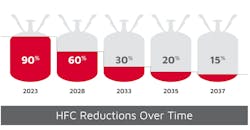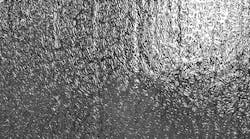With mechanical-insulation systems often representing significant financial investments, it behooves facility managers to be aware of the causes and negative effects of insulation damage. Often, the causes and effects are difficult to identify because of the many types of insulation available and the varying nature of indoor and outdoor environments. A thorough knowledge of the factors involved in a given system often is required to fully understand how best to prevent insulation damage and the large expenses associated with it.
The bottom line is that if mechanical insulation is not installed and maintained properly, a facility is at risk of various types of damage that may not be obvious to the untrained/uninitiated.
While some facility managers may be anxious to get insulation installed, as out of sight is out of mind, it is important to make time for a thorough inspection before installation to avoid inconvenient and costly repair and replacement fees later.
What’s the Damage?
Commercial insulation systems can fall prey to several types of damage, depending on the location and conditions of the facility. One particularly dangerous condition is moisture. Insulation easily can be damaged by both water-vapor and liquid-water absorption, which lead to issues such as mold and mildew. Another major cause of damage is heat, particularly in areas where high-temperature gases or liquids are transported through pipes or ducts close to insulation that is not properly rated for high-temperature conditions. Also, insulation can be damaged from prolonged exposure to sunlight.
People are another leading cause of damage to insulation systems. One frequent example is maintenance workers carelessly walking on top of insulated pipes or tearing into mechanical insulation to repair a concealed piece of equipment. They may not realize it at the time, but they could be causing severe damage. Any improper techniques used at the time of installation can increase the risk of this type of damage.
The only type of damage to mechanical insulation that is completely unavoidable is that associated with aging/natural wear.
The Bigger Picture
There are many factors besides the root causes of insulation damage outlined above to consider. These factors vary greatly based on the type of insulation being used because of the wide-ranging properties and suitable applications of the different kinds of insulation. The four most common types of insulation for commercial applications—fiberglass, closed-cell foam, polyisocyanurate, and foamglass—each are designed to be used in specific environments and for specific purposes.
Specification and installation of insulation that will stand the test of time requires understanding of the differences between insulation types. For example, because it lacks rigidity, fiberglass insulation can be damaged easily if walked upon, handled roughly during installation, or exposed to the elements without protection provided by an aluminum or a polyvinyl-chloride jacket. Additionally, because of its absorptive properties, fiberglass insulation should not be exposed to water. These aspects of fiberglass insulation limit its appropriateness for walkways, outdoor areas, and washdown areas.
Another example is closed-cell-foam insulation. Recommended for operating temperatures from -297°F to +220°F, it will become hard and brittle and begin to deteriorate if exposed to sunlight or high outdoor temperatures for prolonged periods.
Telltale Signs
To an educated observer, there often are telltale signs a piece of insulation is damaged—for example, tears in the material or breaks in the vapor barrier. Water damage often is evident from the altered appearance of the insulation or jacket. One of the most obvious signs of damage is loose insulation hanging from or falling off pipes.
When signs of damage are not distinctly visible, a problem may be detected through comparison of energy bills, temperatures, and other aspects of a facility a fully functioning insulation system should regulate. If everything is not as it should be in terms of utility bills or temperatures, a facility manager should be suspicious of mechanical-insulation damage.
When Damage Occurs
Mechanical insulation can become damaged at any point in its life. Most often, damage occurs during construction, when other trades walk on or inadvertently scrape against it. Ideally, when this occurs, insulation should be replaced immediately to avoid costly and frustrating expense for the building owner in the future.
After insulation is installed, damage can occur from exposure to sunlight, heat, or water. Once insulation is damaged, a maintenance technician should evaluate it and determine whether the best move is a repair or a complete replacement.
Even if it is properly installed and attentively maintained, insulation will wear out after years of use and need to be replaced. This is an opportunity for building owners to upgrade the performance and ensure the code compliance of their insulation with newly improved materials.
Negative Side Effects
Damaged insulation not only can be expensive to repair or replace, it can cause a variety of negative repercussions in terms of personnel, cost, and efficiency. For example, if insulation intended to provide protection from a heated pipe or duct becomes damaged, safety will be compromised.
Insulation not only is necessary for proper building functions, it lowers heating and cooling costs by preventing leakage of treated air. Damage to insulation, then, undermines building efficiency and, in turn, leads to higher energy costs.
Another consequence of damaged insulation is its negative impact on processes requiring precise temperature control. Certain processes require specific operating conditions; without insulation to ensure those conditions, accurate process control becomes much more difficult to achieve.
Taking Control
Mechanical-insulation damage would occur far less often if insulation contractors and facility managers followed several very important steps:
- Follow proper installation procedures at all times. One example of a good installation procedure is the posting of signs alerting building occupants of fragile insulation so it is not walked on repeatedly or scraped inadvertently. Another is the fitting of insulation with proper jacketing to help protect it from any environmental factors that may cause damage. A watershed should be provided for all insulated piping exposed to weather to protect against water damage.
- Specify the correct type of insulation for the environment by paying close attention to the specifications of each system. Often, mistakes are made during insulation specification. For example, steam piping may be insulated with closed-cell foam or piping operating at temperatures below freezing may be insulated with fiberglass. Both of these scenarios will result in damaged and non-functional insulation. In all instances, every condition to which insulation will be exposed should be closely compared with the specifications provided by the insulation manufacturer. Also, all interior insulation should be installed after the building envelope is closed and dry to prevent weather damage while the building is under construction.
- Schedule regular inspections of insulation systems to detect any damage as soon as possible and avoid what could become a large-scale repair. If damaged insulation is found during an inspection, it should be replaced immediately to prevent any further damage and to avoid the negative effects it can cause.
Conclusion
Mechanical-insulation systems that are installed, inspected, and maintained properly easily can last 20 years or more. Neglecting these valuable assets to a facility’s infrastructure can lead to damage, harmful conditions, and increased energy expenditures. With correct installation and maintenance techniques, these negative effects are easily avoidable.
Nick Eaton is general manager of ISS Insulation Services & Solutions, a full-service insulation contractor specializing in commercial and industrial projects.
Did you find this article useful? Send comments and suggestions to Executive Editor Scott Arnold at [email protected].









